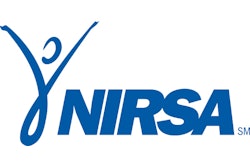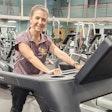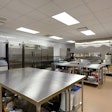Combining collegiate facilities for student life and recreation may be the wave of the future

Integrating the activities of recreation centers and student centers into one common facility is emerging as a new development in college campus design. Traditionally, recreation centers and student centers have been treated as independent structures with separate missions. But as greater thought is being given to the many ways in which these two types of facilities are similar, that view is changing.
What do student centers and recreation centers have in common. Both are critical components of the on-campus student life experience - that is, they contain the activities that students engage in outside the classroom. These activities can include recreation and fitness, dining, studying, or even something as routine as picking up mail at the post office. Often, these activities are scattered across campus, taking place in residence halls, student centers, recreation centers, athletic facilities and performing arts centers.
While there may be plenty of activity satellites, rarely can one building be defined as the center of campus life. Thus the idea of combining the functions of these various facilities into one comprehensive center emerged. This innovative concept is not for every school, but for many institutions, combining facilities has already made a good deal of sense.
Because integrating recreation centers and student centers requires careful planning, it's worthwhile to first examine what components are essential to each type of building. Ultimately, the success of the combined facility will depend on if and how well these elements are incorporated.
A student center or union is traditionally the social hub of a campus. Normally located in or as close to the center of campus as possible, this facility serves as the "campus living room," where students can feel at home. It is a place where they can dine, study in a social environment or simply relax with friends. A variety of lounge areas for other activities such as television viewing or Internet browsing are also commonly found in student centers. Often, student centers house office space for organizations as varied as the campus newspaper, student government, drama club and culinary arts club.
Compared to student centers, recreation centers are a relatively new addition to college campuses, appearing gradually over the past 30 years. Their presence discards the notion that the needs and facilities for intercollegiate athletics and physical education are the same, and have developed as buildings with their own specially designed programs and components.
Some common elements in college rec centers include fitness/weight rooms, basketball courts, jogging tracks, courts for racquet sports, aerobics rooms, locker rooms and swimming pools. Newer features such as climbing walls, multipurpose activity courts and cycling studios help college rec centers keep pace with what's being offered by fitness facilities in the private and public sectors.
Recreation centers also accommodate outing clubs, rowing clubs, martial arts clubs, fencing clubs and roller hockey clubs, to name a few. Apart from their fitness benefits, these clubs also appeal to students on a social level, giving them the opportunity to meet individuals who share their interests.
Recreation centers can be located almost anywhere on campus, but generally are found along its outer rim to provide easy access for commuter students and greater flexibility to accommodate the large building footprint that is often required. Where possible, space is allotted for outdoor components such as swimming pools, play fields, and basketball and sand volleyball courts. It's not unusual to find picnic areas or barbecue pits nearby, as well.
The quality and quantity of such campus assets can significantly affect student recruitment and retention. When students are deciding which institution they will attend, a facility such as a combined student/recreation center can be a powerful attraction. It is an oft-repeated truism that a student makes up his or her mind about a college within the first 15 minutes of a campus tour. In light of this, a number of schools now begin and end their tours at the campus recreation center, student center or combined student/recreation center.
There are a number of considerations to be made when planning and designing a combined student/recreation center. While this process will vary for each school, one common factor to keep in mind is that whatever facility is decided upon needs to be respectful of the campus' scale and architecture.
A centrally based, combined facility may be ideal for smaller institutions with enrollments between 2,000 and 5,000 students because of the opportunity to establish a campus nucleus while getting the most out of limited financial resources. On the other hand, larger institutions of 15,000 to 30,000 could find that their combined facility would need to be so large that it dominates the heart of campus, overwhelming adjacent spaces.
Student/recreation centers are most successful when the building footprint is superimposed over popular campus paths. This allows students to remain close to classrooms as they recreate, run errands, socialize or eat. Choosing a "front and center" site with maximum and continuous pedestrian circulation will also help ensure a vibrant, around-the-clock atmosphere of activity.
With the increased usage, it will be important to channel traffic patterns as much as possible. The center's main lobby should provide a common "streetscape," offering access to a variety of components. Well-designed multilevel facilities can easily handle congestion on the entry level and direct users to other areas, encouraging maximum building activity. The center's main stairs, open atriums and upper-level balconies should be inviting and provide visitors visual access to interior program areas. These are amenities that should not be underestimated. Students' ability to see other individuals engaged in activities encourages participation and helps blend different components into one cohesive facility.
During late-night hours, many student centers will keep a limited number of areas open (including study areas, food vendors or convenience stores), yet close off the building's remaining program spaces. Because they are access-controlled facilities, it's very easy for recreation centers to operate on a similar schedule. Access to these components can be managed by a card-swipe system. While ensuring that only university members are allowed access to these areas, the system also enables the center's staff to monitor building usage. The card-swipe system can also be designed so that students' cards double as a debit card, allowing them to purchase such items as food, books or supplies anywhere on campus.
In the not-too-distant past, students did not have much choice with regard to class scheduling, which of course affected how and when they could recreate. Today, greater flexibility in class scheduling allows students to work out virtually whenever they please. Combined student/recreation centers maintain that convenience, even for students who can only use the facility late at night.
Limiting entry points is vital to the successful operation of a 24-hour facility. Addressing both security and functionality concerns, the recreation component should be centralized within the center, with access directly adjacent to the "main street." During off-peak hours, a combined center can require students to check in at a single control desk. Then, depending on the size of the facility, a satellite check-in area for recreation and fitness can be provided in addition to the main entry's control point. Facility managers should consider expanding hours to the area that is generally the most popular within a recreation center: the fitness/weights area.
Combining services increases a facility's flexibility. Because they serve a diverse audience, spaces within student/recreation centers must be able to accommodate a variety of activities. This is particularly true of large, open spaces such as meeting rooms and gymnasiums. Meeting rooms will be used by student organizations and recreational clubs, as well as non-campus groups if the space is available for rent to the general public. A gymnasium can double as a banquet hall, and if the facility has a nightclub, that space could also be used as a movie theater.
Food service must also be flexible enough to handle a wide variety of functions, from consolidated catering to campus-wide events. However, many college students "graze," or snack throughout the day, rather than sit down for traditional meals. In addition to providing full-service dining options, a combined facility can offer snack or juice bars that appeal to the largest number of students, including recreation center users who desire nutrition drinks and energy bars.
Some institutions, after realizing how important food access is to students, have even gone so far as to allow students to eat in certain sections of their libraries. The concept of combining the campus center and library (or the campus center, recreation center and library) is another option in campus planning that is being explored.
Yet not all schools are willing to break down the walls between areas that have traditionally been designated for dining and those areas earmarked for study. Flexibility does have its limits. To what degree can a campus's functions and facilities be combined? Spaces such as the bookstore, dance studio and free-weight area, for example, are not ideal for shared use due to their physical characteristics. Depending on the institution, other office spaces may not be ideal for sharing if more prominent clubs or organizations such as student government and Greek life convincingly express the need for a permanent headquarters. Because sharing certain spaces will no doubt present an inconvenience to some groups (whether they are users or maintenance staff), it is useful to weigh early on the benefits of designing for flexibility against the overall cost of doing so.
A community experience is viewed by many as a healthy and necessary component of student life. Not all of life's most important lessons are learned in the classroom. Often, students encounter some of those lessons through building relationships: while having lunch with a group of friends, working out in the fitness center, or participating in in-depth, late-night discussion by a lounge fireplace. Quality spaces for these moments of spontaneous learning are essential for a successful campus.
Creating such a community atmosphere requires the successful integration of individuals from diverse backgrounds into an active environment. Architecturally speaking, a successful community relies on a transparency between a building's exterior and interior. This can animate the spaces surrounding the facility and encourage outdoor activities on adjacent plazas and lawns.
Following this principle of transparency, one New England campus community was revitalized by a renovation and expansion project that integrated its student center and recreation center. The Gladys Sakowich Campus Center at Merrimack College maintains a strong physical presence on campus, thanks to three distinctive rooftop lanterns that landmark the center. The presence of the student center within the combined building has helped increase student use of the campus's recreational facilities. Previously located within the campus's athletic facilities, the recreation component of the new combined center attracts a broader cross-section of the student body. Individuals who previously may not have had the time or the opportunity to visit the campus's athletic facilities now - when they pass through the student center - encounter such areas on a daily basis. They have the option of exercising and participating in recreational sports, eating lunch, checking their mail and socializing with their friends without having to walk across campus.
The center's location also appeals to the community at large, enabling the facility to host non-collegiate events. For example, the gymnasium features dimmable lighting options and a structural rigging grid hidden in the ceiling from which sound systems and theatrical lighting can be suspended. These features allow the gymnasium space to accommodate concerts, lectures, student performances, formal dances and banquets - events that can all be serviced by the facility's main kitchen. The center's versatility has helped enhance the school's and the neighboring area's sense of community, without requiring the costly construction of separate banquet and ballroom facilities.
Institutions that identify the need for both a student center and recreation center along relatively similar timeframes may find a combined project ideal. This is the case at Queen's University in Kingston, Ontario, where an existing complex of student center and recreation, athletics and physical education facilities are in dire need of repair. Initially, each component - which had operated independently of the others for more than 30 years - was slated for separate renovation and expansion, but school officials recently opted to combine the multiple projects into one. The goal of the proposed integration is to increase the quality and quantity of both student center and recreation center programming. The resulting facility at Queen's is expected to challenge the definition of a traditional campus center by becoming an unprecedented multiuse venue.
The financial benefits of a combined center are significant. Construction-related costs are typically reduced when building one facility rather than two, based on economy of scale. Operating and maintenance systems for the combined facility should cost less and be more efficient due to consolidation of mechanical systems. Site utility costs may also be reduced, depending on the location of existing utilities. Operational productivity increases with an efficient system design, not only for building systems but also for building service and delivery. Combined centers can help reduce payroll expenses, as well.
Can two distinct systems of operation work together? The answer appears to be yes. Combined centers are a viable option for many institutions. Through a careful analysis of a campus' social needs, similarities between the service missions of separate facilities may become apparent. These missions can encompass several aspects, including dining options, meeting spaces for clubs and other activities, and leisure space. Altogether, the goal is to provide students with a community atmosphere by maximizing their campus life experience outside the classroom.
Roy V. Viklund ([email protected]) is a principal and director of the sports facilities design group and David L. Damon (dlda [email protected]) is a senior associate at Sasaki Associates Inc., 64 Pleasant St., Watertown, MA 02472, 617/926-3300.




































